Land protected through the Growth Centres Biodiversity Offset Scheme
In the nine years that the program has been operating, 567 hectares of high conservation value land has been permanently protected at 13 locations across western Sydney.
The locations of biobank sites 1 to 13 are shown on this map.
1. Wianamatta Nature Reserve (2008–09)
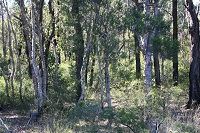 Wianamatta Nature Reserve was purchased in 2009 using funds from the program and other sources, including the Australian Government (see below).
Wianamatta Nature Reserve was purchased in 2009 using funds from the program and other sources, including the Australian Government (see below).
The 181-hectare reserve is located at Cranebrook in Penrith local government area. It provides an important refuge for native animals and plants due to its large size, connectivity and ecological diversity. Read more
2. St Mary’s Towers (2009–10)
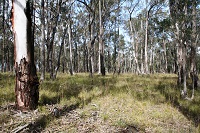 Sandy soil, patchy grasses and trees on the Fernhill Central West biobank site
Sandy soil, patchy grasses and trees on the Fernhill Central West biobank site
In 2010 the first biobank site in New South Wales was established on the St Mary’s Towers property at Douglas Park in south-west Sydney.
The property is owned by the Missionaries of the Sacred Heart, a society of the Catholic Church, and is historically significant as the 1840’s home of the explorer, Sir Thomas Mitchell. Read more
3. Beulah (2010–11)
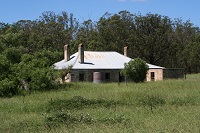 Grasses, scrub and trees on the Glenmore Park biobank site
Grasses, scrub and trees on the Glenmore Park biobank site
Beulah is a 90-hectare historic property near Appin in south-west Sydney. The property has outstanding biodiversity values, including nearly 20 hectares of critically endangered Cumberland Plain Woodland, 40 hectares of critically endangered Shale Sandstone Transition Forest and known koala habitat. Read more
4. Mater Dei (2011–12)
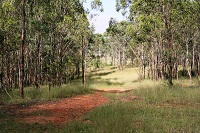 Sandy soil, patchy grasses and trees on the Fernhill Central West biobank site
Sandy soil, patchy grasses and trees on the Fernhill Central West biobank site
The Mater Dei property at Cobbitty has been owned by the Sisters of the Good Samaritan since 1910 and is recognised for its heritage and environmental values. The property’s historic Wivenhoe house is located within a landscape of critically endangered Cumberland Plain Woodland. Read more
5. Mt Hercules (2012–13)
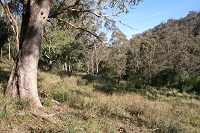 Grasses, scrub and trees on the Glenmore Park biobank site
Grasses, scrub and trees on the Glenmore Park biobank site
The Mount Hercules biobank site permanently protects 22 hectares of high conservation value bushland on the Razorback Range in Wollondilly local government area.
The site contains 19 hectares of critically endangered Cumberland Plain Woodland, 2 hectares of endangered Western Sydney Dry Rainforest and 1 hectare of endangered Moist Shale Woodland. It is also home to the endangered Cumberland Plain land snail. Read more
6. Mulgoa (2012–13)
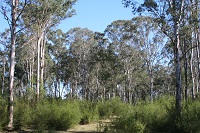 Sandy soil, patchy grasses and trees on the Fernhill Central West biobank site
Sandy soil, patchy grasses and trees on the Fernhill Central West biobank site
The privately-owned Mulgoa biobank site adjoins Mulgoa Nature Reserve and is an excellent example of an important woodland habitat being conserved across land holdings. Private land conservation plays an important role in supporting public reserves, particularly in areas where vegetation communities have been highly cleared and are not well-represented in the public reserve system. Read more
7. Fernhill East (2013–14)
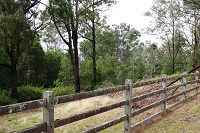 Fernhill Estate is a 648-hectare privately-owned property in Mulgoa in Penrith local government area. The estate contains an 1840s homestead, as well as areas listed as a ‘historic landscape' in the State Heritage Register.
Fernhill Estate is a 648-hectare privately-owned property in Mulgoa in Penrith local government area. The estate contains an 1840s homestead, as well as areas listed as a ‘historic landscape' in the State Heritage Register.
Consistent with the property’s heritage values, the landholder has protected large areas of remnant bushland on the property through biobanking agreements. Read more
8. Orangeville (2013–14)
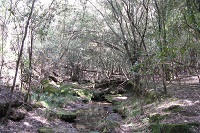 Orangeville biobank site is located on a 125-hectare property in Wollondilly local government area. The property is privately-owned and used for livestock grazing. In 2012, the landowner and OEH agreed to work together to establish a biobank site on 38 hectares of bushland adjoining Wattle Creek at the rear of the property.
Orangeville biobank site is located on a 125-hectare property in Wollondilly local government area. The property is privately-owned and used for livestock grazing. In 2012, the landowner and OEH agreed to work together to establish a biobank site on 38 hectares of bushland adjoining Wattle Creek at the rear of the property.
Much of the bushland on the biobank site is heavily infested with the invasive woody weed African olive.
9. Glenmore Park biobank site (2014–15)
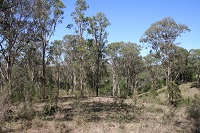 Grasses, scrub and trees on the Glenmore Park biobank site
Grasses, scrub and trees on the Glenmore Park biobank site
The Glenmore Park biobank site was established independently of the program on a rural residential property in Penrith local government area. The site is 15 hectares and covers most of the property.
The biobank site demonstrates the important role that private land conservation plays in supporting public reserves. Read more
10. Fernhill Central West biobank site (2014–15)
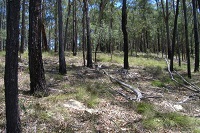 The Fernhill Central West biobank site is the second biobank site established on the Fernhill property (see Fernhill East biobank site).
The Fernhill Central West biobank site is the second biobank site established on the Fernhill property (see Fernhill East biobank site).
The 147-hectare Central West site was formed in 2014. It contains a diverse range of woodlands and forests, and is home to threatened woodland birds such as the varied sittella and glossy black-cockatoo. Read more
11. Mater Dei Stage 2 (2015–16)
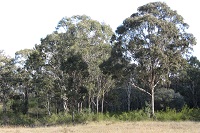 Grasses, shrubs and trees on the Mater Dei Stage 2 biobank site
Grasses, shrubs and trees on the Mater Dei Stage 2 biobank site
In 2015 program staff worked with the landowner to establish a new biobank site at the historic Mater Dei property at Cobbitty (Camden local government area).
The 58-hectare site is located on the banks of the Nepean River next to a 26-hectare biobank site on the property that was protected by the program in 2011–12. Read more
12. Williamswood biobank site (2015–16)
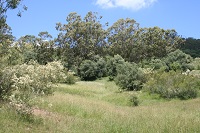 Grasses, shrubs and trees on the Williamswood biobank site
Grasses, shrubs and trees on the Williamswood biobank site
Williamswood is a 124-hectare privately-owned rural property at Mount Hunter (Wollondilly local government area).
A biobank site was established on the property independently of the program in 2015 and protects 104 hectares of threatened bushland. Read more
13. Hardwick Stage 1 (2016–17)
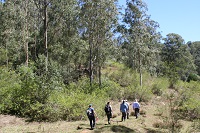 Group of peope walking on a track in bushland on the Hardwicke biobank site
Group of peope walking on a track in bushland on the Hardwicke biobank site
Program funding was used to purchase biodiversity credits, equal to protecting 25 hectares of critically endangered Cumberland Plain Woodland, from the Hardwicke Stage 1 biobank site.
The 57-hectare site is in Orangeville in Wollondilly local government area and was created independently of the program in 2017. Read more
